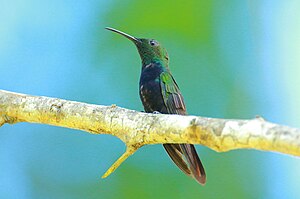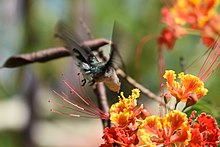Hispaniolas Emerald Hummingbird
| Hispaniolas Emerald Hummingbird | ||||||||||
|---|---|---|---|---|---|---|---|---|---|---|

Hispaniolas Emerald Hummingbird, male |
||||||||||
| Systematics | ||||||||||
|
||||||||||
| Scientific name | ||||||||||
| Chlorostilbon swainsonii | ||||||||||
| ( Lesson RP , 1829) |
The Hispaniolasmaragdkolibri ( Chlorostilbon swainsonii ) or Swainsonkolibri is a species of bird in the family of hummingbirds (Trochilidae). The species is endemic to Hispaniola . The IUCN assesses the population as Least Concern .
features
The male Hispaniolas emerald hummingbird reaches a body length of about 9.5 to 10.5 cm, the female from 8.5 to 9.5 cm. The weight varies between approx. 2.5 and up to 5 g. The male has a black upper bill, the lower bill is red. The beak is slightly curved in the front third. The anterior skull, the skull and the cheeks are matt dark brown. The rest of the top and the flanks are dark green with some bronze, the upper tail-coverts are dark green. The green on the bottom is darker than on the top. The shimmering green throat is replaced by a large black spot in the middle of the abdomen. The under tail-coverts are dark green. The strongly forked tail is dark brown. The female's beak is significantly more curved than that of the male. The front skull, the skull and the cheeks are also matt dark brown. The rest of the top and the flanks are dark green with a bronze tint, the upper tail-coverts are dark green. The underside is gray, dark on the belly and on the under tail coverts. The outer control feathers are gray at the base and have a broad dark brown subterminal band with white spots. The next control feathers are grass green at the base and then slowly fading into black. The rest of the control springs are green. Fledglings resemble females in appearance.
Behavior and nutrition
The Hispaniolas emerald hummingbird gets its nectar from flowering inga vera , Heliconia bihai , Rhytidophyllum auriculatum , Caesalpinia pulcherima and from plants of the genus Aechmea and hibiscus . As trapliners, they regularly fly to very specific, scattered flowers in quick succession. They hunt insects in flight. They get their food up to 14 meters above the ground.
Vocalizations
Their calls sound like metallic twittering tones and they sometimes utter them in long series.
Reproduction
Breeding activities of the Hispaniola emerald hummingbird can be observed from January to June, and there are occasional nests until late August. The chalice-like nest is relatively large and consists of moss, fern fibers and other plant material. The outside is decorated with braids and cobwebs. They often build their nests in low trees or undergrowth 0.5 to 2.0 meters above the ground. A nest was discovered on a vine on the bank of a road. In the highlands in the southwest of the Dominican Republic , 30 nests were found at heights between one and ten meters. The clutch consists of two eggs. The incubation period lasts 15 to 16 days and the eggs are only incubated by the soaking. The chicks are dark gray with two dark stripes in the back of the body. The nestlings fledge at around 20 to 22 days. The first own brood takes place in the second year of life of the young hummingbirds.
distribution and habitat
The Hispaniolas emerald hummingbird prefers dense mountain forests, shady coffee plantations, forest edges and scrub at altitudes between 300 and 2500 meters. Occasionally you can meet him at sea level, very rarely at altitudes up to 3075 meters. Foraging is done 3 to 18 meters above the ground.
migration
Hispaniola emerald hummingbirds are believed to be resident birds that migrate seasonally at high altitudes. Most of the time they stay in the upper altitudes and may move to brood and further down in winter.
Subspecies
The species is considered to be monotypical .
Etymology and history of research

René Primevère Lesson described the Hispaniolas emerald hummingbird under the name Ornismya Swainsonii . He erroneously stated Brazil as the collection point. It was John Gould who introduced the new genus Chlorostilbon in 1853 . Only later was the Hispaniolas emerald hummingbird assigned to this genus. "Chlorostilbon" is made up of the Greek words "chlōros χλωρός " for "green" and "stilbōn στίλβων " for "shining". The Greeks gave Mercury the nickname Stilbōn, which is due to the verb "stilb" for "blink". The species name "swainsonii" is dedicated to William Swainson .
literature
- Ralf Bündgen, Guy Maxwell Kirwan in: Josep del Hoyo , Andrew Elliott, Jordi Sargatal, David Andrew Christie , Eduardo de Juana: Hispaniolan Emerald (Chlorostilbon swainsonii) in Handbook of the Birds of the World Alive . Lynx Edicions, Barcelona.
- James A. Jobling: Helm Dictionary of Scientific Bird Names . Christopher Helm, London 2010, ISBN 978-1-4081-2501-4 .
- René Primevère Lesson : Histoire naturelle des oiseaux-mouches, ouvrage orné de planches desinées et gravée par les meilleurs artistes et dédié A SAR Mademoiselle. - 81 plates (Prêtre, Antoine Germaine Bévalet, Marie Clémence Lesson after Louis Pierre Vieillot, Antoine Charles Vauthier after William Swainson, Pancrace Bessa , Elisa Zoé Dumont de Sainte Croix) . Arthus-Bertrand, Paris ( biodiversitylibrary.org - 1829-1830).
- John Gould: A monograph of the Trochilidæ, or family of humming-birds . tape 5 , delivery 5. Taylor and Francis, London 1853 ( biodiversitylibrary.org ).
- Frederick Herschel Waterhouse: The dates of publication of some of the zoological works of the late John Gould, FRS RH Porter, London 1885 ( biodiversitylibrary.org ).
- Edward Clive Dickinson, Leslie K. Overstreet, Robert Jack Dowsett, Murray Duncan Bruce: Priority! The Dating of Scientific Names in Ornithology . Aves Press Limited, Northampton 2012, ISBN 978-0-9568611-1-5 .
Web links
- Chlorostilbon swainsonii inthe IUCN Red List of Endangered Species 2018.1. Listed by: BirdLife International, 2016. Retrieved November 11, 2018.
- BirdLife International: Species Factsheet - Hispaniolan Emerald ( Chlorostilbon swainsonii ) . Retrieved November 11, 2018.
- Videos, photos and sound recordings for Hispaniolan Emerald (Chlorostilbon swainsonii) in the Internet Bird Collection
- Hispaniolas Emerald Hummingbird ( Chlorostilbon swainsonii ) at Avibase; accessed on November 11, 2018.
- Chlorostilbon swainsonii in the Integrated Taxonomic Information System (ITIS). Retrieved on 2018-11-11.
- xeno-canto: Sound recordings - Hispaniolan Emerald ( Chlorostilbon swainsonii )
- Hispaniolas Emerald Hummingbird (Chlorostilbon swainsonii) in the Encyclopedia of Life . Retrieved November 11, 2018.
Individual evidence
Remarks
- ↑ For the publication history of the work, see Edward Clive Dickinson u. a. S. 117. The work was published in 17 deliveries from 1829 to 1830. S. XVII was published in May 1829.
- ↑ According to Frederick Herschel Waterhouse p. 47, Plate 355 appeared as part of Delivery 5 from 1853. Here Gould assigned the Chlorostilbon prasinus , a synonym for the blue-tailed emerald hummingbird ( Chlorostilbon mellisugus ( Linnaeus , 1758)) to the genus.

